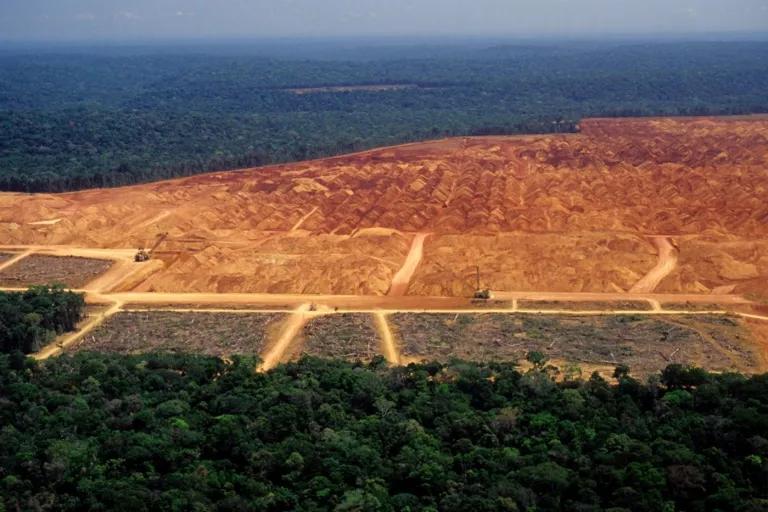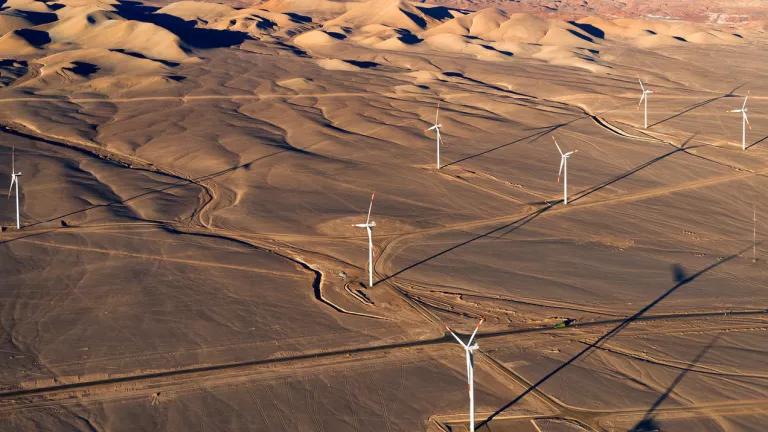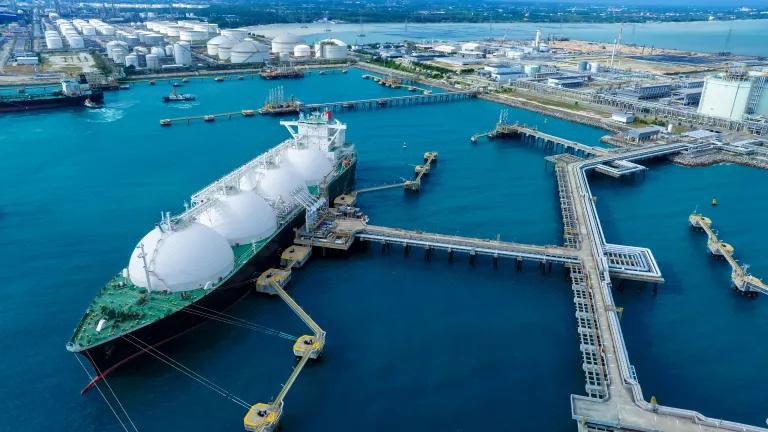Beyond Pledges: Solidifying Climate Action in Latin America
Climate change and associated extreme events are amplifying factors in migration and displacement while exacerbating social, economic, and environmental burdens. Latin America is among the regions with the greatest documented need for the strengthening of early warning systems.

It is imperative that leaders at the national level in Latin America take an active role in the 2022 United Nations climate summit (COP27) talks to tackle the climate crisis that has left an unprecedented trail of destruction over the last few years. The hydrometeorological hazards the region undergoes—including droughts, heat waves, cold waves, tropical cyclones, and floods—have unfortunately led to the loss of hundreds of lives, severe damage to crop production and infrastructure, and human displacement. Yet at the same time, deforestation in the Brazilian Amazon has surged to its highest rate in the last 15 years, putting it at risk of becoming a net carbon emitter of CO2 while suffering a massive loss of biodiversity. Elsewhere in the region, countries continue to rely on fossil fuel extraction. All countries across the region know firsthand the impacts of climate change and need concrete action from leaders at the national level toward the global climate agenda.
This is a pivotal point for the region, and more than pledges and plans are necessary. According to the Climate Analytics and NewClimate Institute’s Climate Action Tracker and the latest Intergovernmental Panel on Climate Change report, some of the biggest countries in Latin America and the Caribbean have yet to commit to the actions necessary to achieve the goal of limiting the rise in average global temperatures to 1.5 degrees Celsius via their Nationally Determined Contributions (NDCs). Laggard countries such as Brazil and Mexico, the largest greenhouse gas (GHG) emitters in the region, need to urgently reboot their climate policies. Even Colombia, which played a protagonist role at the previous COP for its ambitious climate announcements, is facing the same problems: the lack of a road map to the implementation of climate actions and the adoption of the principle of climate justice. Even in the midst of what seem to be positive recent developments that could be a potential turning point for Brazil and Mexico, actions speak louder than words.
Current outlook of major Latin American countries
Mexico
This moment in time can be a turning point for Mexico to tap into its vast renewable energy resources to create new economic opportunities and build a cleaner, more sustainable future for local communities. Just days before the start of COP27, Mexico indicated its commitment to reduce its GHG emissions by 30 percent by 2030, an increase from the previous target of 22 percent. Additional recent developments include PEMEX’s pledge to capture up to 98 percent of methane emissions and Mexico joining a declaration advancing the transition to 100 percent zero-emission cars and vans by 2040. PEMEX’s commitment is especially significant, as methane emissions comprise approximately 21 percent of Mexico’s total GHG output. Also, Mexico announced it will share the Sonora plan at COP27, which focuses on solar energy, lithium, and semiconductors in a bid to turn the state into an electric vehicle hub. Finally, at last year’s COP26, Mexico joined the Declaration on Forests and Land Use, part of the global effort to halt and reverse forest loss and land degradation by 2030.
At this point, however, more than pledges and vague plans are necessary to turn Mexico into a climate leader. The local NGO, Iniciativa Climática de México (ICM) released this week, amid COP27, an NDC proposal driven by civil society to aid the government of Mexico in updating and increasing its climate ambition from a climate justice perspective. The proposal coincides with the government on a non-conditional 30 percent target by 2030, but its conditional target is more ambitious than the one announced by the government. The document is supported by multiple studies to back up the feasibility of the new proposed targets; at the same time, it provides a road map on how to deliver on them. In the webinar to launch the proposal, the group highlighted that implementation would be key and that current policies by the government are not aligned with a more ambitious NDC target.
Indeed, in the past three years, Mexico has taken a steady stream of actions to weaken its renewable energy sector and unfairly bolster its fossil fuel industry as it has generally deprioritized climate action. Mexico’s actions against the renewable energy industry—including U.S. firms—contributed to the United States calling for consultations under the United States–Mexico-Canada Agreement (USMCA). Additionally, Mexico is presently ranked in the top 10 countries for forest loss, with nearly 300,000 hectares of primary forest gone in 2020 alone. The government is building a new oil refinery in Dos Bocas, which could become a stranded asset in less than 20 years. Furthermore, President, Andrés Manuel López Obrador (popularly known as “AMLO”) has cut the budget for disaster management and climate change. Mexico’s Supreme Court revoked a definitive suspension of reforms to the AMLO-backed electric industry law, which sought to re-establish its Federal Electricity Commission’s market power, thereby discouraging private investment in solar and wind. Rather than putting the brake on renewable energy, the Mexican government should embrace new opportunities and technologies.
Looking beyond COP27, it is laudable that Mexico is reviewing and strengthening its commitments. However, it’s clear that current policies will not let Mexico achieve more ambitious emissions reduction targets. The NDC proposed by the civil society might offer some answers to create the road map that the country so urgently needs to deliver more ambitious targets. And as emphasized during the launch, it provides technical elements to show that a more ambitious NDC is technically, economically, and legally possible. In the conditions in which Mexico finds itself today, it is urgent for the country to step back from its anti-climate energy policies and focus instead on a green recovery that brings clean energy jobs and builds more resilient communities.

A flaming gas flare at an offshore oil production site in the Gulf of Mexico
Brazil
With the recent election of Luiz Inácio Lula da Silva, hopes are high for a more environmentally friendly change in leadership for Brazil. However, reinstating its conservation credentials will be harder than simply swapping out leaders. On the positive side, President-elect Lula has pledged to prioritize climate action and end deforestation. According to the head of his political party, he agreed to meet with U.N. Secretary-General António Guterres (among other national representatives), and when he addressed COP27 he promised that "Brazil is back". During Lula’s last administration (2003–2010), Brazil reduced the Amazon’s deforestation rate by more than 70 percent. With stronger environmental credentials, Brazil had also championed encouraging wealthy countries to fund climate mitigation and adaptation efforts under Lula. This effort was successful; in 2008, Germany and Norway created a fund with the Brazilian government to assist with Amazon conservation efforts.
But Lula will face struggles to reverse Brazil’s environmental destruction, as former president Jair Bolsonaro actively dismantled ecological protections, legitimized illegal environmental activity, and supported policies that opened the Amazon to large-scale mining, oil and gas extraction, and other destructive practices. During Bolsonaro’s administration, the Brazilian government’s GHG emissions reduction commitment of 50 percent by 2030 was merely a rehash of a promise made in 2015 during the Paris Climate Conference (COP21), which was ultimately insufficient for meeting the current goal of limiting warming to 1.5 degrees Celsius. One of the most critical areas of forest worldwide is the Amazon, and the rate of deforestation in Brazil is the highest it’s been in the last 15 years. If that trend continues, the Amazon will become a net emitter of CO2 and will suffer a massive loss of biodiversity. The Brazilian Ministry of Environment signed onto the Glasgow Leaders’ Declaration on Forests and Land Use; however, Brazil’s commitments will only apply to illegal deforestation while the declaration makes no such distinction. There are no indicators showing that Brazil has begun to address this problem, and prior environmental spending proposals have been vetoed.
To get Brazil back on track, Lula will need to immediately start enforcing existing forest protection laws (according to an analysis by Carbon Brief, full implementation of the Forest Code could result in deforestation dropping by 89 percent by 2030); rebuild environmental agencies; strengthen protection of Indigenous peoples and environmental defenders; regulate agrobusinesses; and secure sustainable livelihoods, clean energy, and public services for the urban population within the national climate strategy.

An aerial view of deforestation in the Amazon rainforest in northern Brazil
Colombia
Colombia stands out for having an ambitious emissions reduction commitment proposal of 51 percent by 2030, making its proposal to decarbonize by 2050 feasible, if appropriately implemented. It also has committed to reducing its black carbon emissions by 40 percent by 2030, which would lead to improved air quality and public health within its cities. And Colombia furthered its commitment to protecting forests, signing onto several agreements covering deforestation, land use, and ocean protection. Additionally, an expansion of its protected marine areas, as part of the 30x30 initiative, seeks to protect 30 percent of marine and terrestrial areas by 2030. Colombia also signed the “Because the Ocean” Declaration, committing even further to marine conservation.
Despite these ambitious targets, Colombia’s current commitments have been classified by the Climate Action Tracker as “highly insufficient,” and for good reason. The Agriculture, Forestry and Other Land Use sector is responsible for 58 percent of Colombia’s GHG emissions. The country’s high dependence on fossil fuel exports for revenue remains a key political factor for any incoming government. At a minimum, fracking pilot projects must be stopped and coal exports phased out. Furthermore, Colombia needs to: establish concrete climate adaptation actions for a number of its economic sectors, especially agriculture; increase its carbon tax price and coverage; and make improvements to the design and implementation of its emissions trading schemes.
Sound plans to tackle deforestation is critical. Given the low environmental ambitions of key Colombian economic sectors, excluding land use and forest, the country needs to set firm domestic policies in place to deliver on its targets, and commit to fully protecting natural areas on land and in the oceans.

A mother and her young daughter harvesting onions on a farm in Colombia
Countries across Latin America must take an active role and develop road maps toward their climate targets
As outlined above, Latin American countries must embrace more sustainable energy options, protect their forests and lands, and speed up their transition from fossil fuel investments (particularly refining). In addition, governments must be held accountable for their commitments, with a focus on a just and equitable transition to net-zero emissions. Climate change and associated extreme events are amplifying factors in migration and displacement while exacerbating social, economic, and environmental burdens. Latin America is among the regions with the greatest documented need for the strengthening of early warning systems. Extreme rainfall—causing flooding and landslides—has set records in many places throughout the region and created substantial losses, including hundreds of fatalities and tens of thousands of homes destroyed or damaged. The increasing harms to agriculture have also hurt global crop markets. At COP27 and beyond, local governments need to show with concrete action plans that they support the climate agenda, and they must enable true progress with sound policies to transform their economies toward sustainability.




